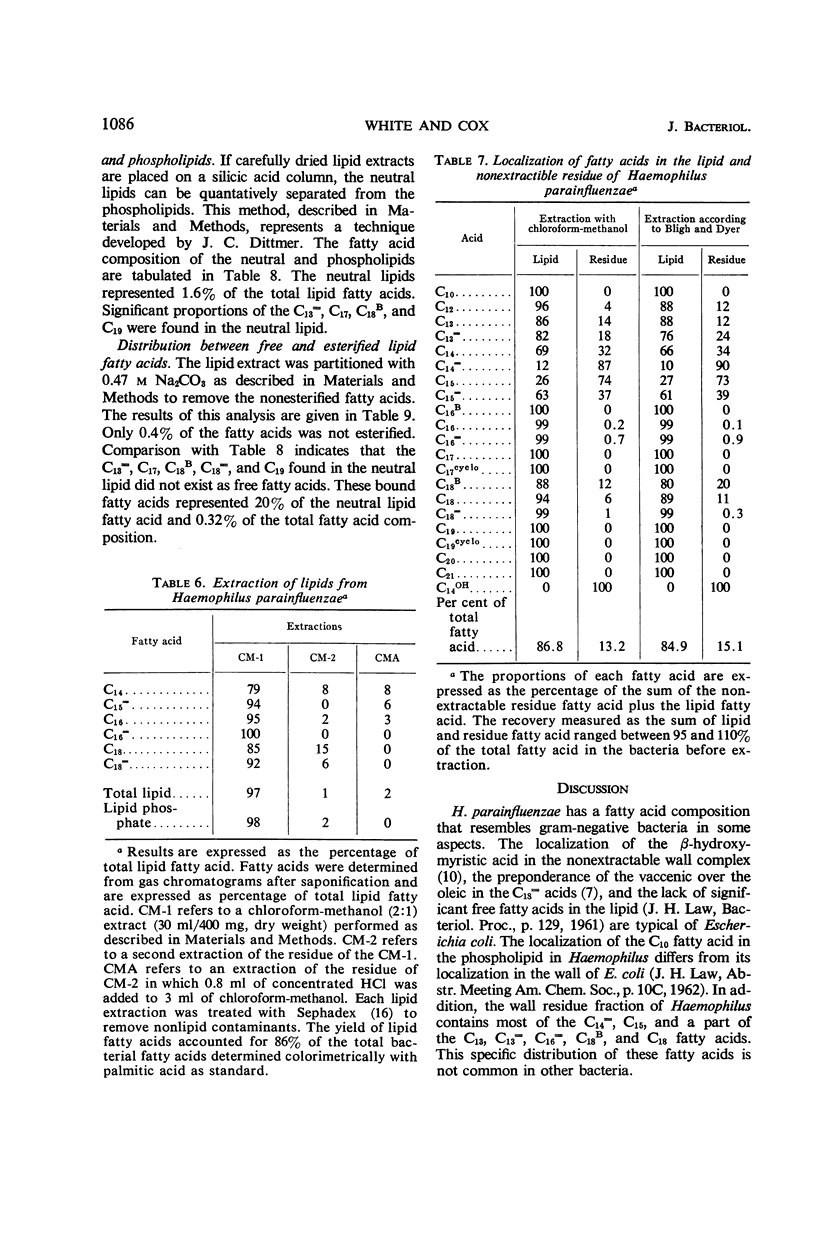Abstract
Haemophilus parainfluenzae was capable of synthesizing 22 fatty acids. These fatty acids were equivalent to 4% of the bacterial dry weight. These fatty acids were localized in the membrane-wall complex, which contained the respiratory pigments, the quinone, and the phospholipids. The fatty acids which could be extracted with organic solvents comprised 86% of the total fatty acids of the cell. These fatty acids were distributed as 98% in the phospholipids and 1.9% in the neutral lipids, of which 0.5% were free fatty acids. Palmitic, palmitoleic, oleic, and vaccenic acids comprised 72% of the total fatty acids and were found almost exclusively in the phospholipids. The phospholipids also contained the cyclopropane fatty acids. The neutral lipids contained significant proportions of the odd-numbered branched and straight-chain fatty acids. The principal free fatty acids were n-dodecanoic and pentadecenoic acids. The nonextractable wall complex contained 14% of the total fatty acids. These wall fatty acids were rendered soluble only after saponification. The wall fraction contained all of the β-hydroxymyristic acid and most of the myristoleic and pentadecenoic acids. The significance of the distribution of fatty acids between nonesterified, neutral lipid, phospholipid, and nonextractible wall remains to be determined.
Full text
PDF









Selected References
These references are in PubMed. This may not be the complete list of references from this article.
- BARTLETT G. R. Phosphorus assay in column chromatography. J Biol Chem. 1959 Mar;234(3):466–468. [PubMed] [Google Scholar]
- BLIGH E. G., DYER W. J. A rapid method of total lipid extraction and purification. Can J Biochem Physiol. 1959 Aug;37(8):911–917. doi: 10.1139/o59-099. [DOI] [PubMed] [Google Scholar]
- FOLCH J., LEES M., SLOANE STANLEY G. H. A simple method for the isolation and purification of total lipides from animal tissues. J Biol Chem. 1957 May;226(1):497–509. [PubMed] [Google Scholar]
- HILDEBRAND J. G., LAW J. H. FATTY ACID DISTRIBUTION IN BACTERIAL PHOSPHOLIPIDS. THE SPECIFICITY OF THE CYCLOPROPANE SYNTHETASE REACTION. Biochemistry. 1964 Sep;3:1304–1308. doi: 10.1021/bi00897a020. [DOI] [PubMed] [Google Scholar]
- JAMES A. T. Qualitative and quantitative determination of the fatty acids by gas-liquid chromatography. Methods Biochem Anal. 1960;8:1–59. doi: 10.1002/9780470110249.ch1. [DOI] [PubMed] [Google Scholar]
- KANESHIRO T., MARR A. G. cis-9,10-Methylene hexadecanoic acid from the phospholipids of Escherichia coli. J Biol Chem. 1961 Oct;236:2615–2619. [PubMed] [Google Scholar]
- NESBITT J. A., 3rd, LENNARZ W. J. COMPARISON OF LIPIDS AND LIPOPOLYSACCHARIDE FROM THE BACILLARY AND L FORMS OF PROTEUS P18. J Bacteriol. 1965 Apr;89:1020–1025. doi: 10.1128/jb.89.4.1020-1025.1965. [DOI] [PMC free article] [PubMed] [Google Scholar]
- NOVAK M. COLORIMETRIC ULTRAMICRO METHOD FOR THE DETERMINATION OF FREE FATTY ACIDS. J Lipid Res. 1965 Jul;6:431–433. [PubMed] [Google Scholar]
- O'leary W. M. THE FATTY ACIDS OF BACTERIA. Bacteriol Rev. 1962 Dec;26(4):421–447. doi: 10.1128/br.26.4.421-447.1962. [DOI] [PMC free article] [PubMed] [Google Scholar]
- WELLS M. A., DITTMER J. C. THE USE OF SEPHADEX FOR THE REMOVAL OF NONLIPID CONTAMINANTS FROM LIPID EXTRACTS. Biochemistry. 1963 Nov-Dec;2:1259–1263. doi: 10.1021/bi00906a015. [DOI] [PubMed] [Google Scholar]
- WHITE D. C. Cytochrome and catalase patterns during growth of Haemophilus parainfluenzae. J Bacteriol. 1962 Apr;83:851–859. doi: 10.1128/jb.83.4.851-859.1962. [DOI] [PMC free article] [PubMed] [Google Scholar]
- WHITE D. C. DIFFERENTIAL SYNTHESIS OF FIVE PRIMARY ELECTRON TRANSPORT DEHYDROGENASES IN HEMOPHILUS PARAINFLUENZAE. J Biol Chem. 1964 Jun;239:2055–2060. [PubMed] [Google Scholar]
- WHITE D. C. FACTORS AFFECTING THE AFFINITY FOR OXYGEN OF CYTOCHROME OXIDASES IN HEMOPHILUS PARAINFLUENZAE. J Biol Chem. 1963 Nov;238:3757–3761. [PubMed] [Google Scholar]
- WHITE D. C., SMITH L. LOCALIZATION OF THE ENZYMES THAT CATALYZE HYDROGEN AND ELECTRON TRANSPORT IN HEMOPHILUS PARAINFLUENZAE AND THE NATURE OF THE RESPIRATORY CHAIN SYSTEM. J Biol Chem. 1964 Nov;239:3956–3963. [PubMed] [Google Scholar]
- WHITE D. C. SYNTHESIS OF 2-DEMETHYL VITAMIN K2 AND THE CYTOCHROME SYSTEM IN HAEMOPHILUS. J Bacteriol. 1965 Feb;89:299–305. doi: 10.1128/jb.89.2.299-305.1965. [DOI] [PMC free article] [PubMed] [Google Scholar]
- WHITE D. C. THE FUNCTION OF 2-DEMETHYL VITAMIN K2 IN THE ELECTRON TRANSPORT SYSTEM OF HEMOPHILUS PARAINFLUENZAE. J Biol Chem. 1965 Mar;240:1387–1394. [PubMed] [Google Scholar]
- White D. C. The obligatory involvement of the electron transport system in the catabolic metabolism of Haemophilus parainfluenzae. Antonie Van Leeuwenhoek. 1966;32(2):139–158. doi: 10.1007/BF02097454. [DOI] [PubMed] [Google Scholar]


